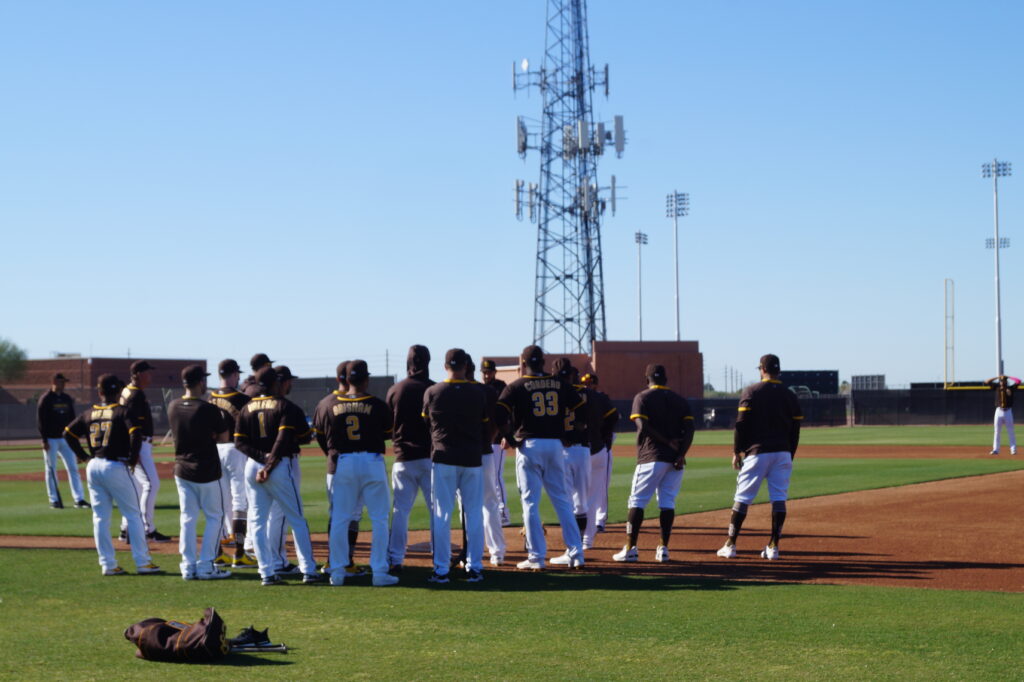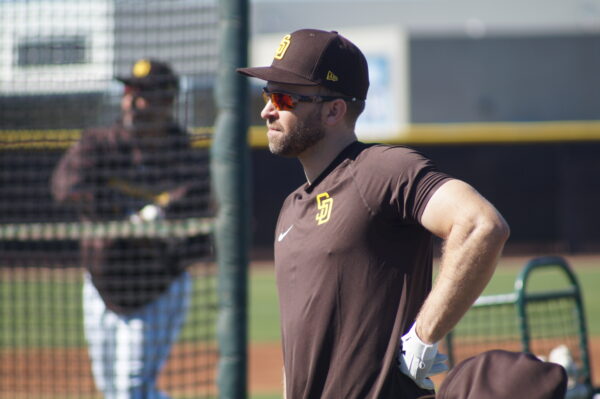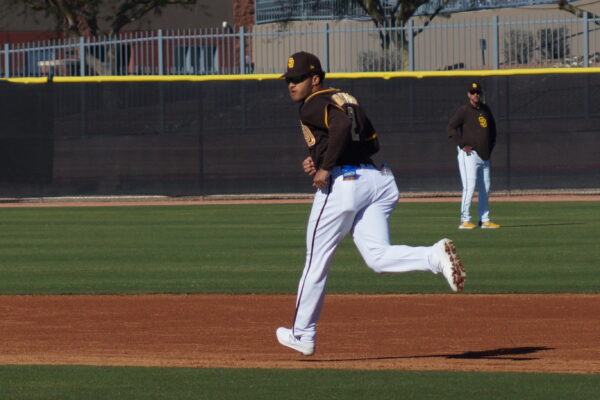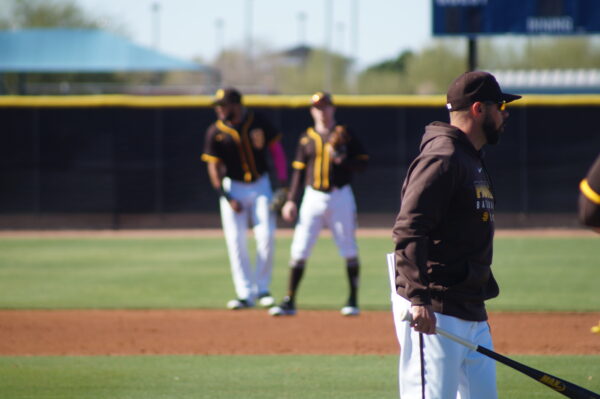Clubhouse chemistry, mixing old and new to be key for Padres in 2020


The San Diego Padres are hoping for a successful 2020 season.
Brian Dozier has been to the top of the mountain. The newly signed Padres second baseman has tasted the champagne after the last game of the season and hoisted the Commissioner’s Trophy above his head. So he knows what it takes, the kind of team it takes, to get there and succeed on baseball’s biggest stage.
“It is tough (to succeed at that level),” Dozier said of his World Series experience. “I think one of the main things I’ve learned from the past couple of years is that you gotta want to come to the ballpark and expect to win.”
Coming from a Washington Nationals team that defied expectations last postseason as they completed their historic championship run, it makes sense that Dozier preaches the value of having lofty goals as a group. But paired with Dozier’s self-prescribed high expectations is something else that he brings to the San Diego clubhouse — an expectation that winning teams will have fun, and gel as the season progresses. As part of their charmed 2019 campaign, Dozier and the rest of the Nationals led the league in several categories, but perhaps none as visibly as one intangible: team chemistry. Their high-spirited dugout antics, which engaged veterans and rookies alike, were a feel-good story throughout the year.
“Whenever you can be carefree and have fun — in the clubhouse, outside, everything — wins start piling up,” Dozier said.
For the first half of last season, the Padres were similarly long on both success and fun. Fernando Tatis Jr. dazzled both on and off the field as he enjoyed one of the most electric rookie (half) seasons in San Diego history. Chris Paddack delighted with his country-western ethos, putting up dominant results alongside his sheriff persona. And Manny Machado brought a new swagger to the team after signing in free agency.
San Diego emerged as a team that appeared ready to turn the proverbial corner back to relevancy as they finished the first half at 45-45 (.500). That was, however, until a 25-47 (.347) second half doomed them to a return to what has been the status quo at Petco Park, at least results-wise.
Tangibly speaking, San Diego’s rough finish could be attributed to injuries (Tatis), and trading away one of the team’s most prolific power hitters (Franmil Reyes). But many pointed towards a decline in chemistry and clubhouse culture down the stretch, with rumors of a less than ideal vibe in the locker room abounding as the season wound down.
Perhaps intertwined with that last notion is the idea that part of the Padres’ second-half collapse last season could be attributed to a simple lack of experience on their roster. A deficiency that could have contributed to both the team’s results on the field, and their inability to band together off of it. In terms of sheer youth, the numbers don’t lie: San Diego ranked as the youngest, and second-youngest team in terms of average batter and pitcher age in all of Major League Baseball, with their batters being an average of 26.1 years old (second youngest), and the team’s pitchers clocking in at an average of 26.3 years of age (youngest).
This off-season has seen the team add more experienced players like outfielder Tommy Pham and Dozier, of course, but the roster is still youthful at its core.
Thus, finding a way to maximize team chemistry and help those young players acclimate to the major leagues as quickly as possible figures to be important. With a diverse blend of players that ranges from high-profile stars like Machado, to young hotshots like Tatis Jr. and Paddack, to veterans like first baseman Eric Hosmer and right-handed pitcher Garrett Richards, to the immensely talented but inexperienced crown-jewel prospects waiting in the wings like pitchers Mackenzie Gore and Luis Patiño, ensuring that each of the Padres’ players brings value to each other will likely prove to be integral to the team’s success moving forward. And putting together a complete season could start with successfully meshing the organization’s major-league talent with the wealth of prospects that figure to matriculate to “The Show” in the coming months.
Just ask the 32-year-old Dozier, whose previous team succeeded on the backs of players as old and grizzled as 35-year-old Ryan Zimmerman, and players as fresh-faced as the prodigious, impossibly youthful 21-year-old Juan Soto.
“There’s a lot of young guys (on the Padres), obviously,” Dozier said. “But there’s a good group of veterans on this team too that have been around and have won. I’ve been a part of some good teams, and you gotta have the collaboration of both groups. In this clubhouse specifically, it’s kind of like that.”
Having played eight previous seasons in the big leagues so far, Dozier has plenty of experiences to reflect on as he enters a new chapter in his career. But a younger player, 23-year-old outfielder Trent Grisham, also new to San Diego, shared his sentiment regarding the dynamics in the clubhouse so far this spring as well.
“There’s a lot of components to make a winning team,” Grisham said. “Myself, I’m laid back, I’m very easygoing, I like to have a lot of fun, I’m chill. But you gotta have (intense) guys in the clubhouse, not everybody can be easygoing. Every day we gotta be able to hold each other accountable.”

The question going forward, then, will be, how do all these pieces fit together? The young and the old, the “intense” and the “chill”? Beyond the early-spring assessments of the locker room, beyond the accurate but perhaps flimsy platitudes tossed around this time of year regarding clubhouse dynamics, how do the Padres plan to ensure that players like Gore and Patiño, for example, can benefit most from being around more experienced pitchers? How will they ensure that Tatis Jr. and other infield prospects can continue to benefit from playing alongside a generational talent in Machado? That Grisham develops from being around lauded veteran Tommy Pham?
Manager Jayce Tingler’s answer might surprise you.
“Some of the veterans, I think, have done an outstanding job of maybe setting some boundaries,” Tingler said when asked of his approach to balancing the team’s relationships between younger and older players. “With that being said, we understand that to get where we want to go; we’re probably going to need 50-54 players throughout the year. So, it’s important to understand the boundaries and the rules, and it’s also important to understand that we want (younger players) to feel welcome, and we want them to be themselves when they come up. And I think that some of the leaders, some of the veterans on the team have done a really good job with that so far.”
His approach to bridging that gap is likely well informed. Tingler has a deep background in player development, spending the last 14 years with the Texas Rangers organization as a manager in the Dominican Winter/Summer Leagues and Arizona Rookie League, also serving as the Rangers’ minor league coordinator, assistant general manager and interim bench coach before he became the Padres’ manager late last October. What he lacks in big-league managerial experience, he makes up for with his extensive resume working with prospects. And given how much of the Friars’ future success hinges on the development of their historically deep farm system, that’s probably a good thing.

“I would say that the young guys have done a great job of blending into a clubhouse as well,” Tingler added. “So, it’s been a really good balance.”
Mackenzie Gore, a cornerstone of San Diego’s farm system and perhaps the most heralded of all of the Padres’ current prospects is certainly one of those “young guys” Tingler mentioned. In the midst of his first MLB spring training, one that precedes a season that could feature his highly anticipated major-league debut, the 21-year-old left-handed pitcher fielded questions from reporters in San Diego’s locker room after a conversation between himself and several teammates reached a pause.
His locker situated between fellow left-hander Matt Strahm, All-Star closer Kirby Yates, and some other big leaguers — an arrangement that is likely no accident — Gore weighed in on what the presence of the team’s more experienced players has been like for him.
“It’s been great,” Gore said, economical with his words but sincere in his reply. “The guys have been good at welcoming me, and it’s been a lot of fun so far.”
And so it will be boundaries, some give and take, an expectation that rookies will assimilate, but veterans will educate that will characterize the Padres’ new approach to maintaining clubhouse chemistry. It’ll be a dash of Doziers’ ethos of high expectations but high levels of fun, a little bit of the give and take between different personalities that Grisham mentioned, some intensity from Pham, and a lot of desire by their manager that his players are themselves.
Barring any last-minute additions to the roster — which should never be ruled out with general manager A.J. Preller at the helm — the ingredients for this year’s Padres season have been assembled. Now, to wait and see how they all mix. Will it be a half-baked effort for the Friars like the one they set forth in 2019? Or will it be a recipe for success?
Only time will tell.
Anderson Haigler is a freelance sports journalist from Escondido, California. This year is his third contributing to the East Village Times. Anderson recently graduated from the University of San Diego with a degree in Communication Studies, where he won three awards from the CCMA for both his sports and breaking news coverage for The USD Vista.